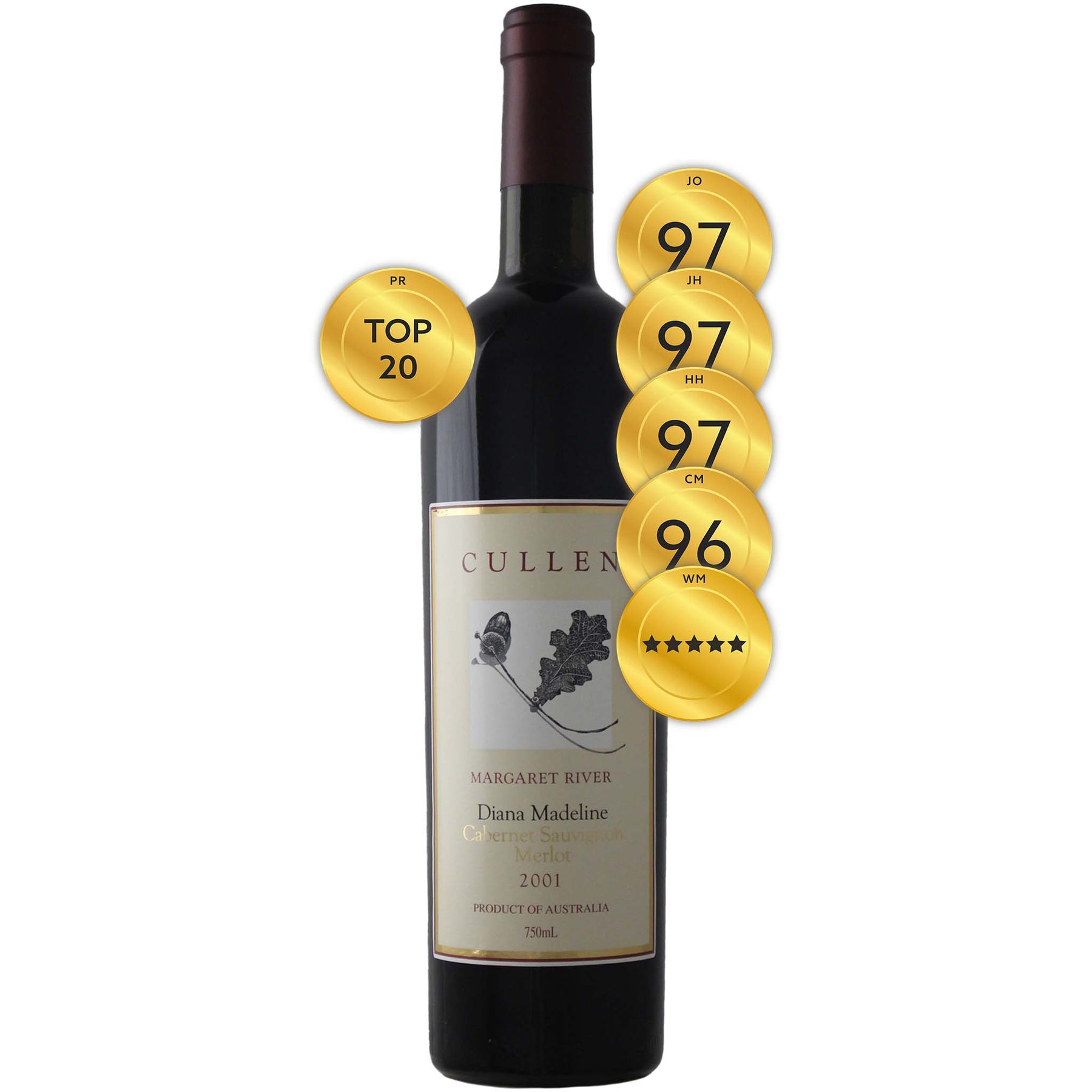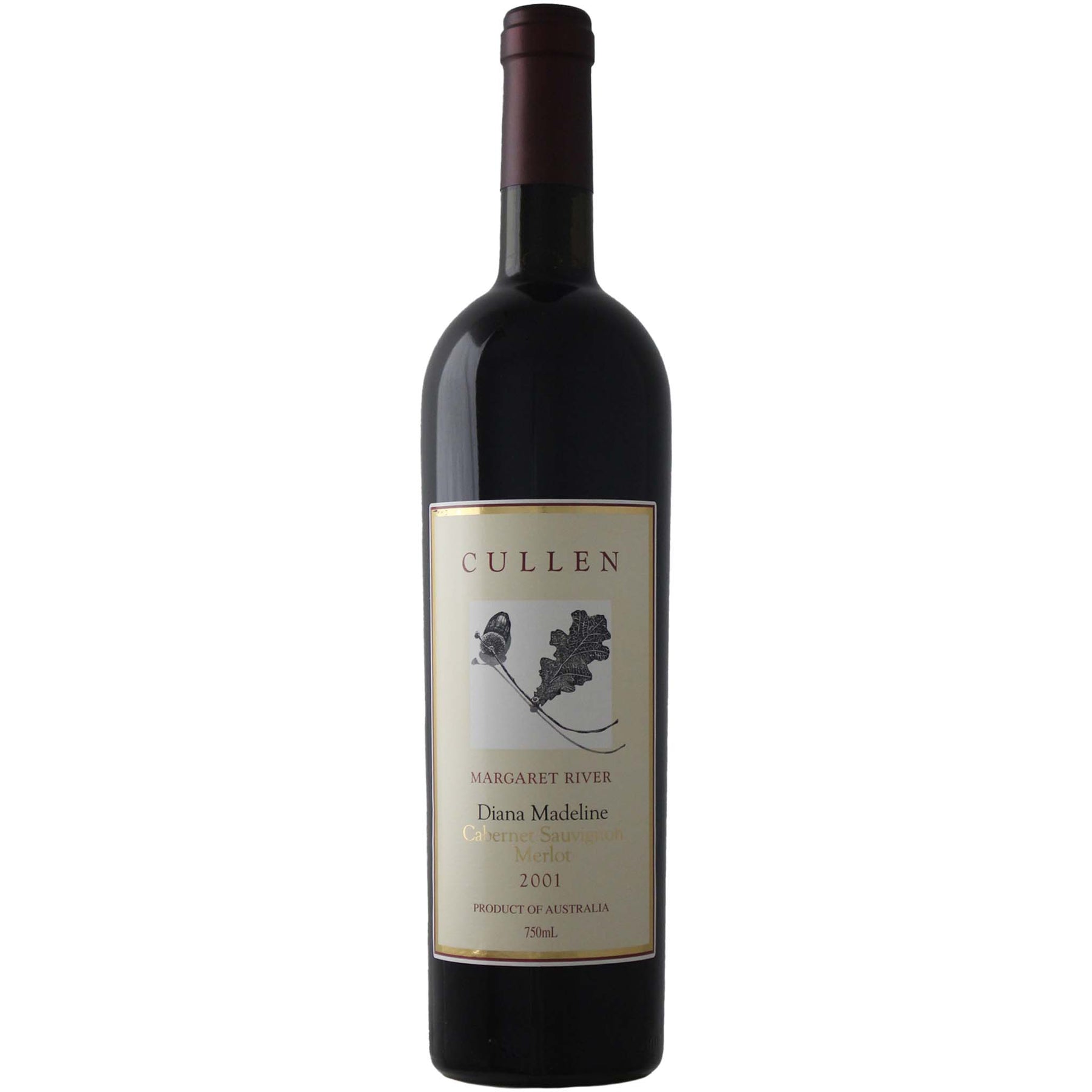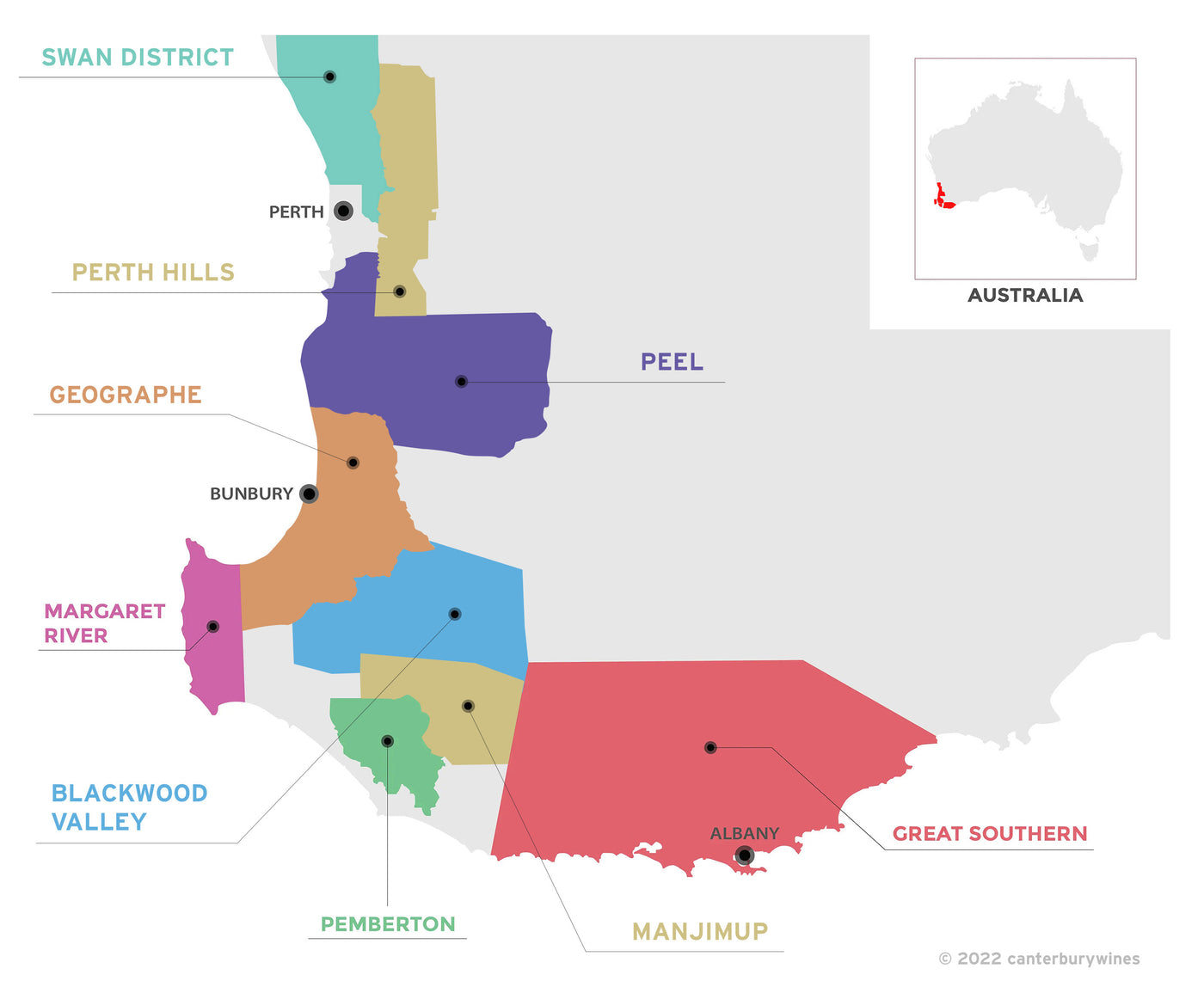

Cullen Diana Madeline 2001
Style: Red Wine
Closure: Cork
Cullen Diana Madeline 2001
Warehouse
34 Redland Drive
Vermont VIC 3133
Australia
Critic Score: 97 and ★★★★★
Alcohol: 14.0%
Size: 750 ml
Drink by: 2028
Philip Rich Top 20 Wines of 2003
Cullen is an iconic Margaret River winery and the Diana Madeline is their flagship red wine. It is famed for its quality and consistency, is sought after by collectors world-wide and is a worthy regional benchmark. It is a classic Cabernet Sauvignon dominant Bordeaux blend grown on an exemplary vineyard. By 2001 Cullen had changed to total organic viticultural practices and was well down the path to Organic Certification.
"Wonderful wine, elegant and yet concentrated, deep and yet light on its feet, drinking superbly right now at 17 years. There are complex bottle-developed aroma notes to the bouquet and the wine is elegant, medium to full-bodied and beautifully balanced. No sign of greenness. A top vintage of this wine." Huon Hooke (Tasted Jan 2018)
"Vanya Cullen has taken her Cabernet Merlot into the top echelon of Australian Cabernet through dogged determination, curiosity and superb technical skills. The exemplary vineyard site is planted on ancient granitic soils in the central Willyabrup sub-region of Margaret River. Cullen has adopted the principles of biodynamic viticulture to 'achieve greater individuality of site through working with nature rather than against it'. This estate style is about freshness and complexity, structure and suppleness. The wines have pronounced cassis and cedar aromas with fine beautifully ripe tannins. Earthy, anise, gamy aromas and flavours develop with age. Diane Madeline Cabernet Merlot is named in memory of Di Cullen who established the winery and vineyard with her husband in 1971." Andrew Caillard MW
Expert reviews
"Wonderful wine, elegant and yet concentrated, deep and yet light on its feet, drinking superbly right now at 17 years. There are complex bottle-developed aroma notes to the bouquet and the wine is elegant, medium to full-bodied and beautifully balanced. No sign of greenness. A top vintage of this wine. Drink 2018-2028." Huon Hooke, The Real Review - 97 points (Tasted Jan 2018)
"2001 Cullen Cabernet Sauvignon Merlot. Cellaring: 25 to 30 years to go." James Halliday, Wine Companion Magazine Feb/Mar 2014 - 97 points
"There's absolutely no stopping Cullen, the signature vineyard and winery in Margaret River. Last weekend the Cullen family played host to a number of media, trade and friends and over two mornings staged vertical tastings of their premier wines, the Sauvignon Blanc Semillon blend, Chardonnay and Cabernet Sauvignon Merlot. An exceptional and world-class event that few wineries could match in quality terms, it became an appropriate tribute to the life and work of Diana Cullen... The other astonishing new wine, and one I rated at least the equal of any other at this tasting, was the 2001 Cabernet Sauvignon Merlot, of which a small portion of around 180 cases was sealed under a screwtop cap. It was winemaker Vanya Cullen's intent to seal more of this wine this way, but a technical packaging hitch prevented her from doing so. I believe the screwcapped bottles have largely been sold out, and they were only available from the cellar door. The interesting thing was just how different the two bottlings actually tasted. The wine sealed under cork (19.4 points, drink 2013-2021+) was everything a Cullen red should be: a superbly polished, presented and harmonious wine of perfume and strength, but the power it exuded was restrained and measured. Saturated in deep fruit and revelling in its cedar/mocha oak influences, it's the complete package, even a little more assertive than the excellent 2000 vintage. As if to contrast and simply make a point, the screwcapped bottling is precisely, according to the current vernacular, a fruit bomb. So much so, in fact, that you can hardly see the oak, which gives you an idea of what real fruit intensity is about. It's heady and opulent, succulent and meaty, and offers a simply unreal length and persistence of exaggerated fruit. Given time, in my experience of red wines sealed this way, the wine will change from the freakish to the simply wonderful. But it will take time, I think, about a decade longer than the cork-sealed alternatives. Drink 2013-2021+." Jeremy Oliver - 97 points
"Bright, electrifying crimson purple. The nose shows eggy sulphur (not a concern) at first but in time blows perfumed herbs, ripe mulberry, blackcurrant and cedar – it's hard work but over time a sense does develop that this is something special. It's not until the wine hits your tongue though that its greatness is revealed – or inferred. In short, it's dramatically structured, with a palate that's brooding and powerful and wrenched tight, with finegrained tannins that rattle right back through the palate in classical style and in doing so bolt its rage of blackcurrant/black cherried fruit rigidly in place. This is a tremendous, statuesque, upstanding wine that shuns cuddly generousity and likeability for the sake of a commanding sense of respect. It's a lesson in how a superior, young, ageworthy cabernet should look. Drink: 2015-2025." Campbell Mattinson, The Wine Front - 96 points
"Made from what is a superb cabernet year in the Margaret River, and named in honour of Di Cullen, who sadly passed away this year, this is without question one of the really great Cullen cabernets – of which there have been a few. Made from 75% cabernet and 25% merlot, this deep crimson-purple-coloured wine has aromas of ripe, pure blackcurrant cabernet fruit, together with cedar and vanilla from perfectly handled French oak, 40% of which was new. The palate has wonderful persistence of flavour and length. Ripe, fine-grained and supple tannins round out a wine that is elegant and concentrated and that will keep improving for many years. This is one of the year's very best wines." Philip Rich, Australian Financial Review, Top 20 Wines of 2003
"An awesome, dense, black colour with magnificent ripe jube fruit aromas seamlessly integrated with cedary oak. Superb, concentrated, varietal fruit on the palate. The oak is subdued and mellow." Winestate Magazine ★★★★★
"The wine was bottled six weeks ago and the tasting bottle had just been opened. The first and most obvious observation is the consistency of style and quality in these wines. At present the wine is locked up tighter than the bank vault on a long weekend but a perfect structure is provided by the velvety, creamy ultra fine grained tannins, balanced but unobtrusive acid and obvious deep concentrated fruit. The body weight is muscular, so it's bigger than the 2000. Structure is big solid layered and tight with an intricate diverse level of complexity; this is a wine with a long finish that will age beautifully. Put simply, this wine is awesome and I will make a big call and say not only is it one of the best wines I have ever tasted, but in my opinion in time it will be one of the best wines ever produced in Australia. Rating? Who needs one with a wine like this! Feb 2003." Ric Einstein, www.torbwine.com
Awards
Top 20 Wines of 2003 - Philip Rich, Australian Financial Review
Organic/biodynamic

The combination of firstly organic, and subsequently biodynamic viticulture at Cullen Wines provides the opportunity for the land to exist at its full potential, thereby nurturing vines to produce their best and most individual grapes. Vanya Cullen has pushed the limits of biodynamic practices in every facet of the business and the yield of the estate vineyards has soared. All Cullen Wines are grown on a certified Biodynamic, Carbon Neutral and naturally powered estate.
Organic Viticulture
Since 1971 when the Cullen Vineyard was planted, chemical intervention was minimal and the family's concern for the environment paramount. In 1998 the change to total organic viticulture was made. Organics is about soil health and Diana and Vanya went intuitively towards healing the soil by putting back what had been taken out. Organic farming promotes biological activity, which converts plant and animal residue into stable humus. This in turn increases the soil's ability to retain moisture and provide a reserve of nutrients. The Cullen vineyards were certified A Grade Organic in 2003.
Biodynamic Viticulture
In 2003, whilst attending a Biodynamic Conference, Vanya Cullen decided that Biodynamics would add further to the holistic and natural approach to both vineyard and winemaking. Biodynamics builds on organic farming to make all organic processes work more efficiently and effectively.
Biodynamic viticulture is a philosophy combining the maintenance of sustainable soil fertility and the recognition of the link between plant growth and the rhythms of the cosmos. Moon rhythms strongly influence life on earth life. As tides rise and fall in a pulsing rhythm, so does the sap of plants and all other liquids including those within the earth's mantle. Viticultural practices are conducted according to these moon rhythms. The position of the moon in relation to the planets is critical in determining the optimal time to plant.
In addition, the difference between organic and biodynamic is the use of biodynamic preparations 500 and 501, with 502-508 also being used. Preparation 500 is cow horns filled with cow manure which helps the soil develop humus and attracts earthworms and micro organisms. Preparation 501 is cow horns filled with quartz crystals which aids photosynthesis and the uptake of minerals in the soil.
In 2004 the Cullen vineyards were certified A Grade Biodynamic.
About the winery

In 1948, Dr Kevin John Cullen and his wife Diana Madeline Cullen purchased their property in Wilyabrup, which is in the heart of Margaret River. In early 1965 they started considering other uses for their sheep and cattle farm. They decided to plant lupins, so invited Dr John Gladstones (who had studied lupins in his post-graduate research) to visit their property. Dr Gladstones had also put considerable work and research into the suitability of growing vines in southwestern Australia and, according to Diana, upon seeing their land said "Oh, you're mad growing cattle and sheep, why don't you grow grapes?"
Dr Gladstones described Wilyabrup as being the sweet spot of the Margaret River region, most favourable for growing Cabernet Sauvignon. In 1966 he published his now-famous report which compared the climate and soils of Margaret River to that of Bordeaux. Many regard him as the founder of the Margaret River wine region.
In 1971 Kevin and Diana Cullen made the decision to plant 18 acres of vines on the land, including their first Cabernet Sauvignon vines. Further plantings were made over the subsequent decades. The mature 28-hectare dry grown vineyard still operates today and the grapes for all the Cullen wines are sourced from here and the adjacent Mangan Vineyard which was planted in 1995.
While Kevin Cullen worked as a doctor to support the business, Diana Cullen supervised and managed the winery and became Chief Winemaker in 1981. Diana made history in 1982 by being the first woman to win a trophy at the Perth Royal Show. Kevin passed away in 1994 and Diana in 2003, and the Cullen flagship wines are now named in their honour; the Kevin John Chardonnay and Diana Madeline Cabernet Sauvignon Merlot. Both Kevin and Diana have been awarded life membership with the Margaret River Wine Industry Association, and in 2003 the WA Wine Industry Association introduced the annual Diana Madeline Cullen Award for Outstanding Contribution by an Individual to the WA Wine Industry in her honour.
In 1983 Diana was joined by daughter Vanya Cullen, who took over the reign as Chief Winemaker in 1989 and was also appointed Managing Director in 1999. With Vanya at the helm, the quality of the wine is paramount and every step taken in the vineyard and in the winemaking is geared to that aim. The quality of Cullen Wines comes in the main from the vineyard - the wines can only be as good as the grapes. To realise the full potential of the vineyard, Vanya has embraced organic and biodynamic viticultural practices and the vineyards were certified A Grade Organic in 2003 and A Grade Biodynamic in 2004.
The process of making the wine involves handling the fruit as little and as gently as possible. Practices such as hand harvesting, minimal fruit transport, sorting of the fruit before crushing, minimal wine movement, minimal fining for the whites, no fining for the reds and minimal filtration are employed. The wines mostly make themselves, with little or no intervention; which means the use of indigenous yeast, no additions of any kind and minimal oak use and fining.
Vanya Cullen received the "Australian Winemaker of the Year" award from Gourmet Traveller Wine magazine in 2000 and was voted "Woman of the Year" by UK based wine magazine The Drinks Business in 2008, becoming the first Australian to receive the award. Vanya was also awarded Halliday Wine Companion's winemaker of the year in 2020.
Cullen became the first vineyard and winery in Australia to be certified carbon positive, starting the process in 2006. Vanya Cullen is also on the board of the "Days of Change" program, which aims to help Western Australian people and businesses live and operate in a more sustainable way.
2021 marked a half-century for the brand and with it a celebration of the Cullen Wines legacy. "This year we celebrate 50 years of Cullen Wines – 50 years of sustainable wine growing preceded by 65,000 years of Wadandi sustainable land care," says Vanya. "Over that time we've been supported by generous people with a wonderful spirit of camaraderie and warmth of spirit, and we are so grateful."


Western Australia
Western Australia is home to more than 400 wineries across nine vast and extraordinary wine regions which are almost entirely concentrated in the south-west and great southern land divisions of the State. The regions are Blackwood Valley, Geographe, Great Southern, Peel, Pemberton, Manjimup, Margaret River and Swan District.
The oldest region is the Swan Valley, the best known both nationally and internationally is Margaret River and the largest is Great Southern. The Great Southern region is further divided into the five subregions of Albany, Denmark, Frankland River, Mount Barker and Porongurup.
The history of wine production in Western Australia dates back to 1840 with the establishment of Sandalford in the Swan Valley region. The recognition of the fine wine possibilities started to be realised after the establishment of the Margaret River Region in 1967, which has become renowned for its high quality Chardonnay and Cabernet Sauvignon. The other regions produce a diverse range of regionally distinct wines, from stunning Rieslings and evocative Shiraz, to a range of unique Cabernet Sauvignon blends.



